A Mesoscale CFD Simulation Study of Basic Wind Pressure in Complex Terrain—A Case Study of Taizhou City
Abstract
Featured Application
Abstract
1. Introduction
2. Wind Data in Taizhou
2.1. Reference Wind Pressure
2.2. Wind Speed Data from Early Meteorological Stations
3. Numerical Simulation
3.1. Method
3.2. Computational Domain
3.3. Boundary Conditions and RANS
4. Results and Discussions
5. Conclusions
Author Contributions
Funding
Institutional Review Board Statement
Informed Consent Statement
Data Availability Statement
Acknowledgments
Conflicts of Interest
References
- Cravero, C.; Leutcha, P.J.; Marsano, D. Simulation and Modeling of Ported Shroud Effects on Radial Compressor Stage Stability Limits. Energy 2022, 15, 2571. [Google Scholar] [CrossRef]
- Hargreaves, D.M.; Wright, N.G. On the use of the k–ε model in commercial CFD software to model the neutral atmospheric boundary layer. J. Wind Eng. Ind. Aerod. 2007, 95, 355–369. [Google Scholar] [CrossRef]
- Tamura, Y.; Ohkuma, T.; Kawai, H.; Uematsu, Y.; Kondo, K. Revision of AIJ Recommendations for Wind Loads on Buildings. In Structures 2004: Building on the Past, Securing the Future 2004; ASCE: Reston, VA, USA, 2004; pp. 1–10. [Google Scholar]
- Wright, N.G.; Easom, G.J. Comparison of several computational turbulence models with full-scale measurements of flow around a building. Wind Struct. 1999, 2, 305–323. [Google Scholar] [CrossRef]
- Ricci, A.; Kalkman, I.; Blocken, B.; Burlando, M.; Repetto, M.P. Impact of turbulence models and roughness height in 3D steady RANS simulations of wind flow in an urban environment. Build. Environ. 2020, 171, 106617. [Google Scholar] [CrossRef]
- Schneider, S.; Santhanavanich, T.; Koukofikis, A.; Coors, V. Exploring schemes for visualizing urban wind fields based on CFD simulations by employing OGC standards. In Proceedings of the ISPRS Annals of the Photogrammetry, Remote Sensing and Spatial Information Sciences, Virtual, 31 August–2 September 2020; Copernicus GmbH: Strasbourg, France, 2020. [Google Scholar]
- Tominaga, Y.; Mochida, A.; Yoshie, R.; Kataoka, H.; Nozu, T.; Yoshikawa, M.; Shirasawa, T. AIJ guidelines for practical applications of CFD to pedestrian wind environment around buildings. J. Wind Eng. Ind. Aerod. 2008, 96, 1749–1761. [Google Scholar] [CrossRef]
- Mochida, A.; Tominaga, Y.; Murakami, S.; Yoshie, R.; Ooka, R. Comparison of various k-εmodels and DSM applied to flow around a high-rise building: Report on AIJ cooperative project for CFD prediction of wind environment. Wind Struct. Int. J. 2002, 5, 227–244. [Google Scholar] [CrossRef]
- Ferziger, J.H.; Perić, M.; Street, R.L. Computational Methods for Fluid Dynamics; Springer: Berlin/Heidelberg, Germany, 2002. [Google Scholar]
- Guideline, V. Environmental Meteorology–Prognostic Micro-scale Wind Field Models–Evaluation for Flow Around Buildings and Obstacles; Beuth Verlag GmbH: Berlin, Germany, 2005. [Google Scholar]
- Verein, D.I. Environmental Meteorology, Physical Modelling of Flow and Dispersion Processes in the Atmospheric Boundary Layer, Application of Wind Tunnels; Verein Deutcher Ingenier: Dusserdorf, Germany, 2000. [Google Scholar]
- Hall, R.C. Evaluation of Modelling Uncertainty-CFD Modelling of Nearfield Atmospheric Dispersion; EU Project EV5V-CT94-0531, Final Report; WS Atkins Consultants Ltd.: Epsom, UK, 1997. [Google Scholar]
- Li, S.H.; Sun, X.J.; Zhang, S.; Zhao, S.J.; Zhang, R.W. A Study on Microscale Wind Simulations with a Coupled WRF-CFD Model in the Chongli Mountain Region of Hebei Province, China. Atmosphere 2019, 10, 731. [Google Scholar] [CrossRef]
- Huang, M.F.; Sun, J.P.; Wang, Y.F.; Lou, W.J. Multi-scale simulation of typhoon wind fields by coupling of weather research and forcasting model and large-eddy simulation. J. Build. Struct. 2020, 41, 63–70. (In Chinese) [Google Scholar]
- Hosseinzadeh, A.; Keshmiri, A. Computational Simulation of Wind Microclimate in Complex Urban Models and Mitigation Using Trees. Buildings 2021, 11, 112. [Google Scholar] [CrossRef]
- Li, M.X.; Qiu, X.F.; Shen, J.J.; Xu, J.Q.; Feng, B.; He, Y.J.; Shi, G.P.; Zhu, X.C. CFD Simulation of the Wind Field in Jinjiang City Using a Building Data Generalization Method. Atmosphere 2019, 10, 326. [Google Scholar] [CrossRef]
- Chang, S.Z.; Jiang, Q.G.; Zhao, Y. Integrating CFD and GIS into the Development of Urban Ventilation Corridors: A Case Study in Changchun City, China. Sustainability 2018, 10, 1814. [Google Scholar] [CrossRef]
- Peng, L.; Liu, J.P.; Wang, Y.; Chan, P.W.; Lee, T.C.; Peng, F.; Wong, M.S.; Li, Y.G. Wind weakening in a dense high-rise city due to over nearly five decades of urbanization. Build. Environ. 2018, 138, 207–220. [Google Scholar] [CrossRef]
- Wang, Q.; Luo, K.; Yuan, R.Y.; Wang, S.; Fan, J.R.; Cen, K.F. A multiscale numerical framework coupled with control strategies for simulating a wind farm in complex terrain. Energy 2020, 203, 117913. [Google Scholar] [CrossRef]
- Duran, P.; Meissner, C.; Casso, P. A new meso-microscale coupled modelling framework for wind resource assessment: A validation study. Renew. Energy 2020, 160, 538–554. [Google Scholar] [CrossRef]
- Antonini, E.; Romero, D.A.; Amon, C.H. Optimal design of wind farms in complex terrains using computational fluid dynamics and adjoint methods. Appl. Energy 2020, 261, 114426. [Google Scholar] [CrossRef]
- Keck, R.E.; Sondell, N. Validation of uncertainty reduction by using multiple transfer locations for WRF-CFD coupling in numerical wind energy assessments. Wind Energy Sci. 2020, 5, 997–1005. [Google Scholar] [CrossRef]
- Kuo, J.; Rehman, D.; Romero, D.A.; Amon, C.H. A novel wake model for wind farm design on complex terrains. J. Wind Eng. Ind. Aerod. 2018, 174, 94–102. [Google Scholar] [CrossRef]
- Dhunny, A.Z.; Lollchund, M.R.; Rughooputh, S. Wind energy evaluation for a highly complex terrain using Computational Fluid Dynamics (CFD). Renew. Energy 2017, 101, 1–9. [Google Scholar] [CrossRef]
- Ke, S.T.; Zhu, R.K. Typhoon-Induced Wind Pressure Characteristics on Large Terminal Roof Based on Mesoscale and Microscale Coupling. J. Aerosp. Eng. 2019, 32, 04019093. [Google Scholar] [CrossRef]
- Huang, W.F.; Zhou, T.; Chen, X. Wind environment assessment of typical building groups by using CFD numerical simulation. J. Hefei Univ. Technol. (Nat. Sci. Ed.) (China) 2019, 42, 415–421. [Google Scholar]
- Huang, M.F.; Li, Q.; Xu, H.W.; Lou, W.J.; Lin, N. Non-stationary statistical modeling of extreme wind speed series with exposure correction. Wind Struct. 2018, 26, 129–146. [Google Scholar]
- Huang, M.F.; Li, Q.; Chan, C.M.; Lou, W.J.; Kwok, K.; Li, G. Performance-based design optimization of tall concrete framed structures subject to wind excitations. J. Wind Eng. Ind. Aerod. 2015, 139, 70–81. [Google Scholar] [CrossRef]
- Jones, W.P.; Launder, B.E. The prediction of laminarization with a two-equation model of turbulence. Int. J. Heat Mass Tran. 1972, 15, 301–314. [Google Scholar] [CrossRef]
- Yakhot, V.; Orszag, S.A. Renormalization group analysis of turbulence. I. Basic theory. J. Sci. Comput. 1986, 1, 3–51. [Google Scholar] [CrossRef]
- Shih, T.; Liou, W.W.; Shabbir, A.; Yang, Z.; Zhu, J. A new k-ϵ eddy viscosity model for high reynolds number turbulent flows. Comput. Fluids 1995, 24, 227–238. [Google Scholar] [CrossRef]
- Kim, H.G.; Patel, V.C.; Lee, C.M. Numerical simulation of wind flow over hilly terrain. J. Wind Eng. Ind. Aerod. 2000, 87, 45–60. [Google Scholar] [CrossRef]
- Ministry of Housing and Urban-Rural Development of the People’s Republic of China. Load Code for the Design of Building Structures (GB 50009-2012); China Architecture and Building Press: Beijing, China, 2012. (In Chinese) [Google Scholar]
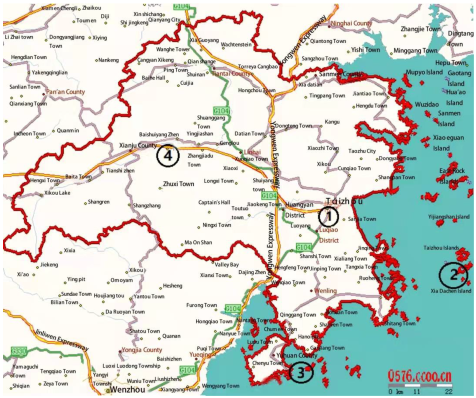
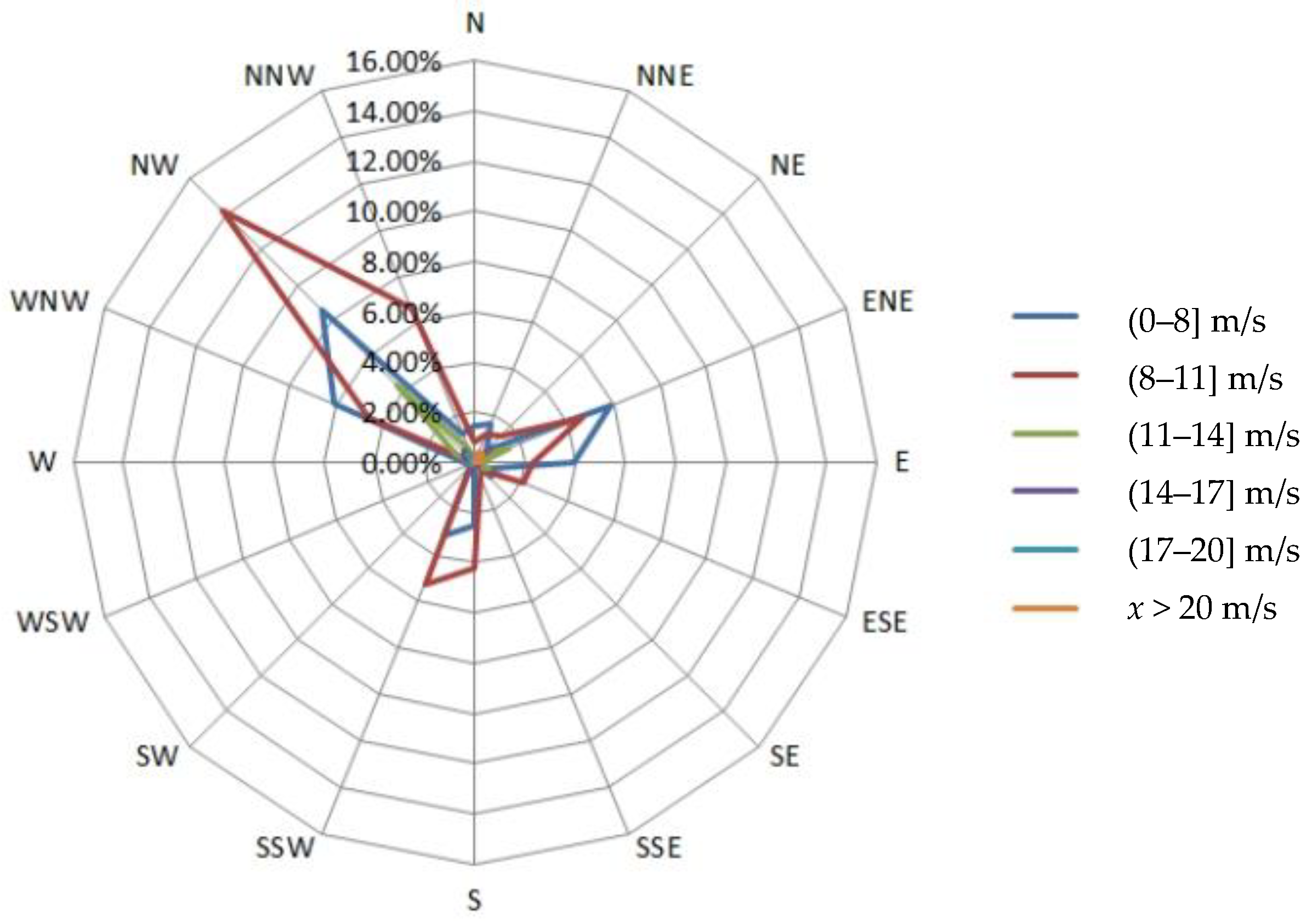
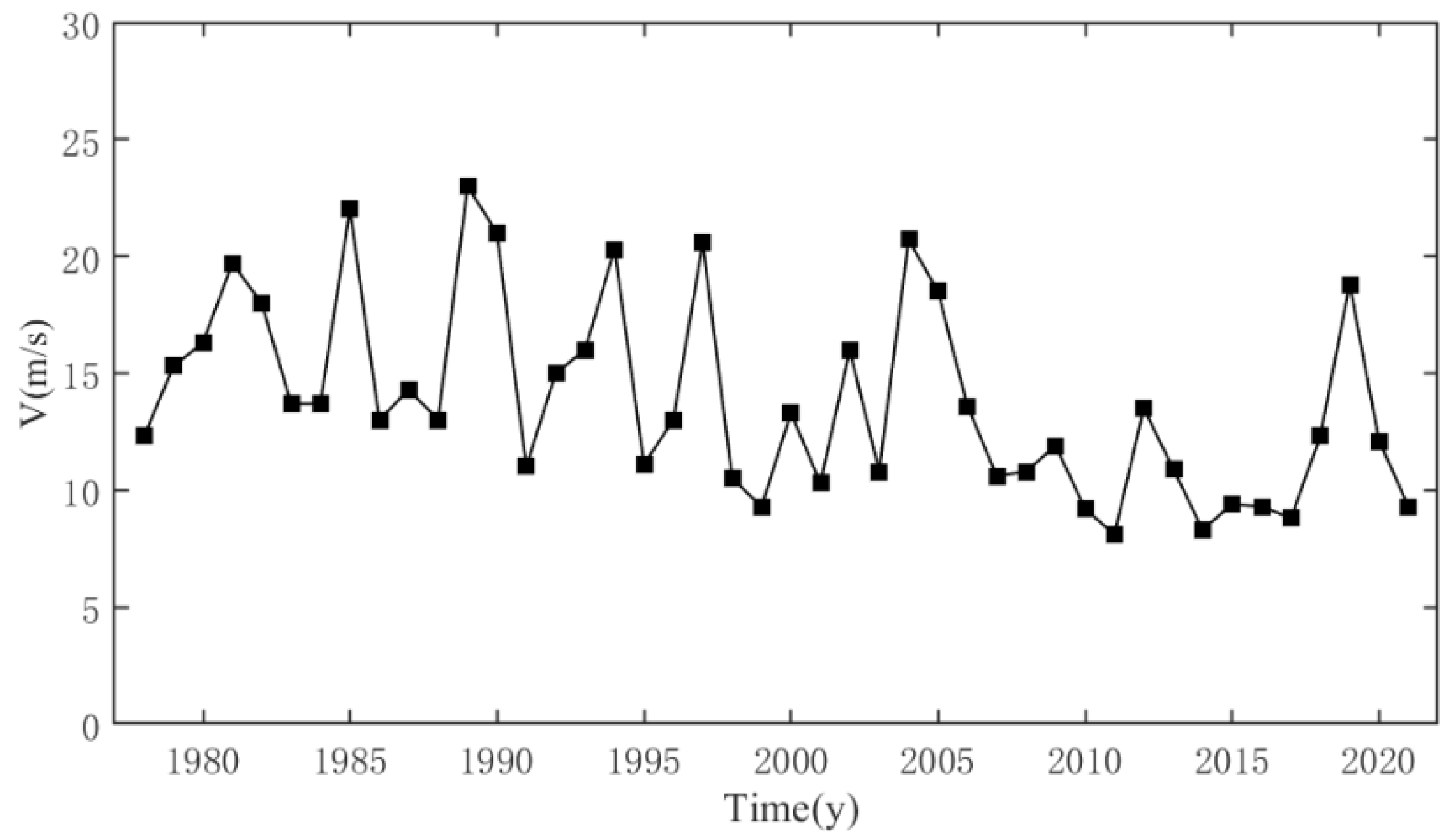
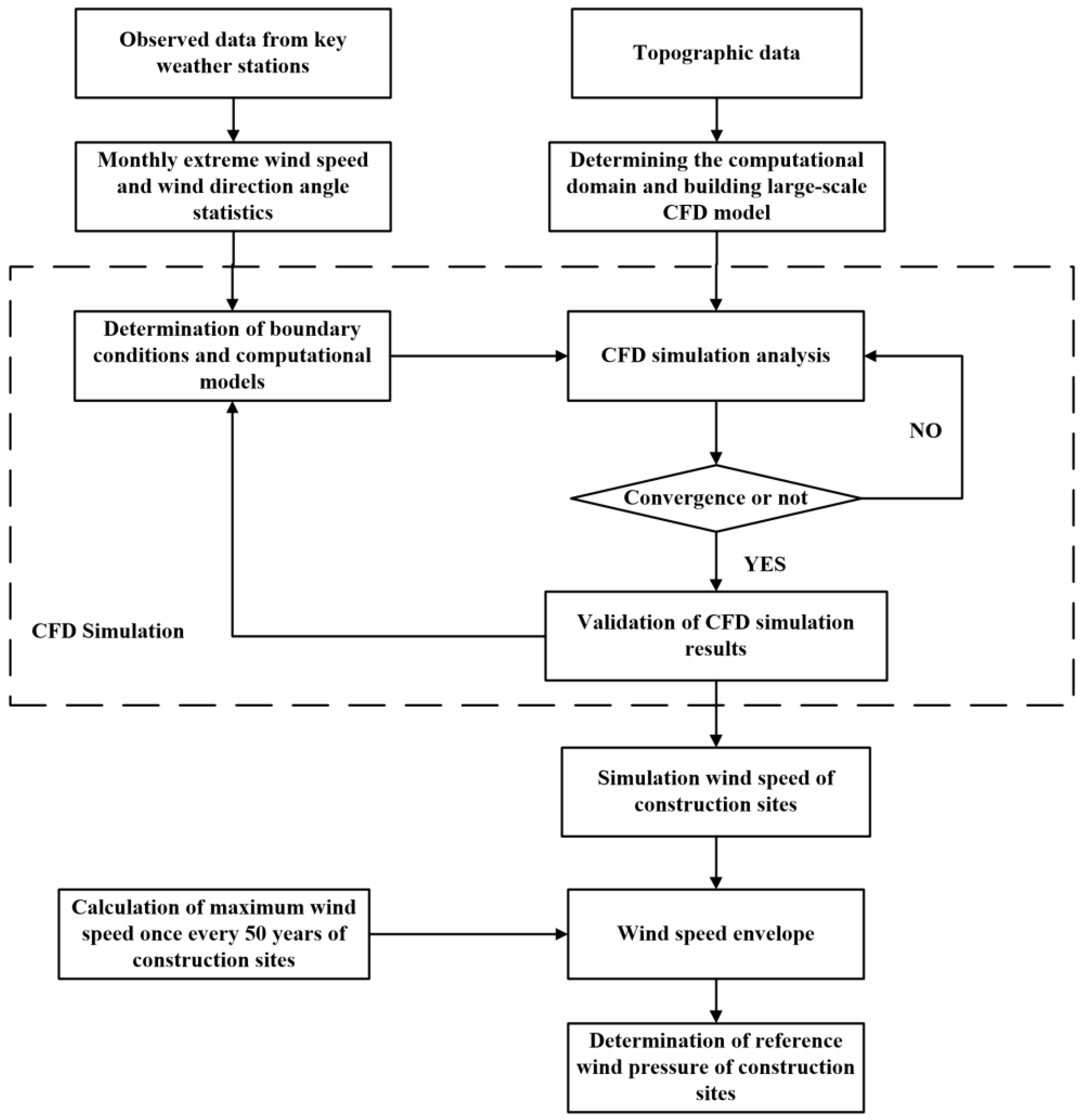
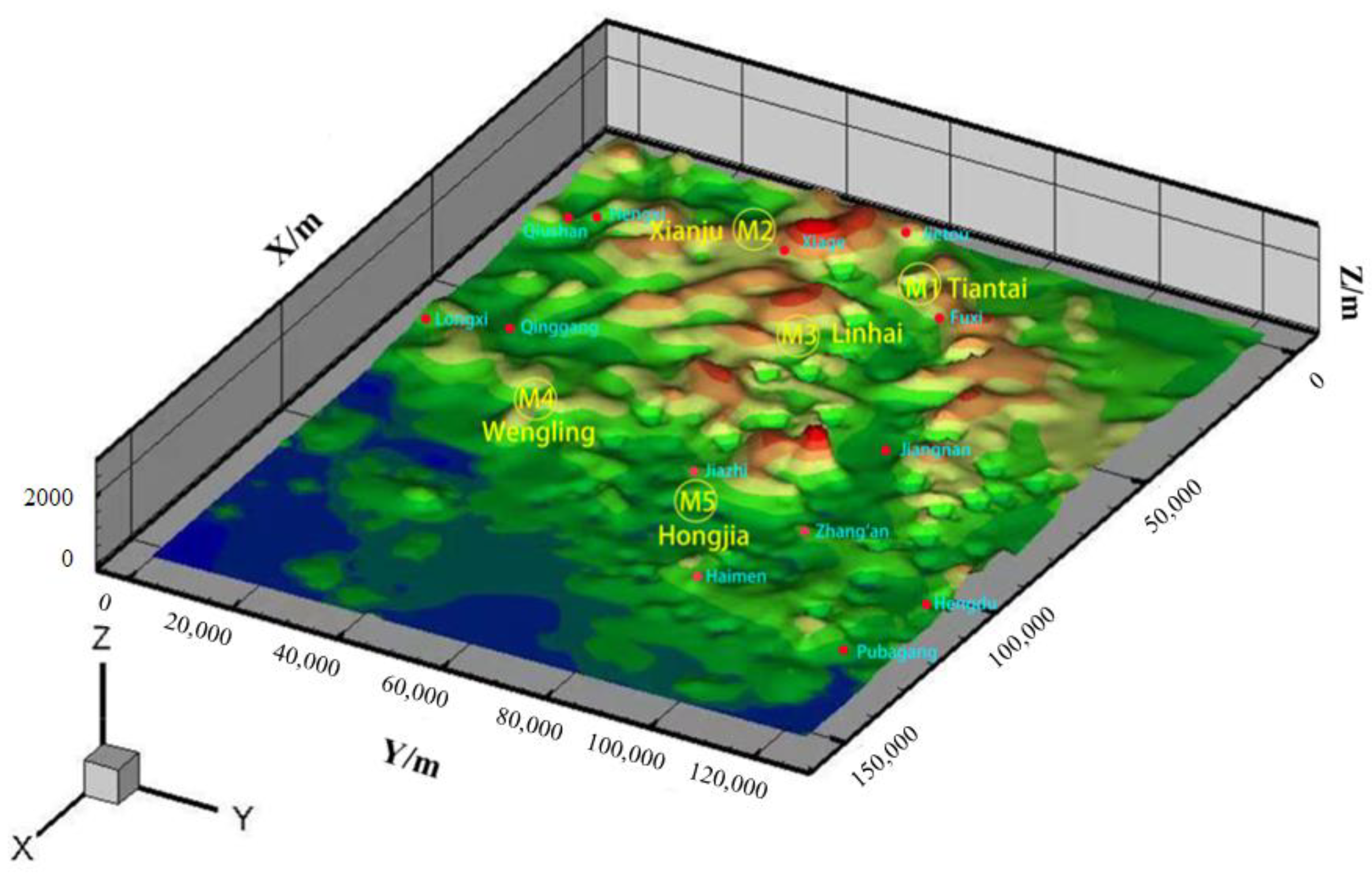


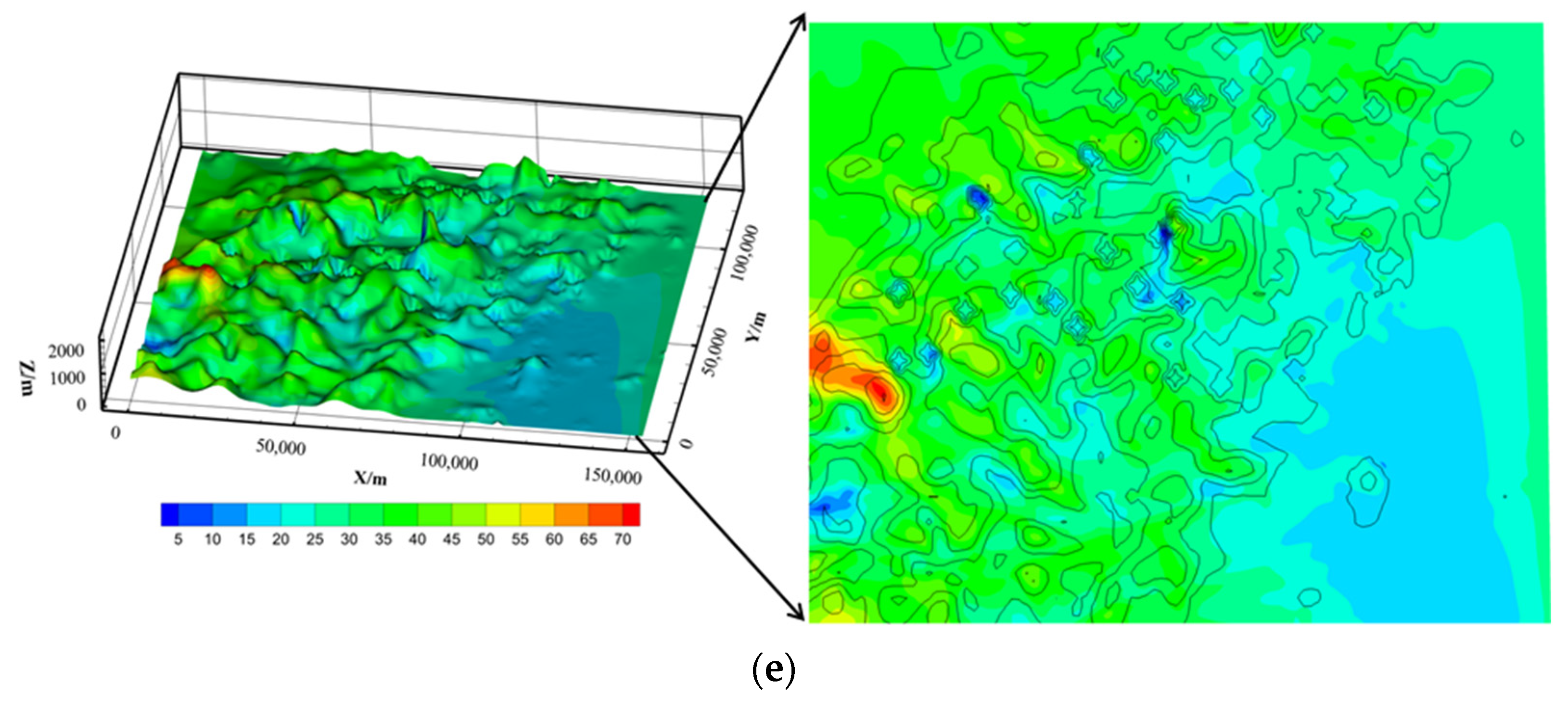
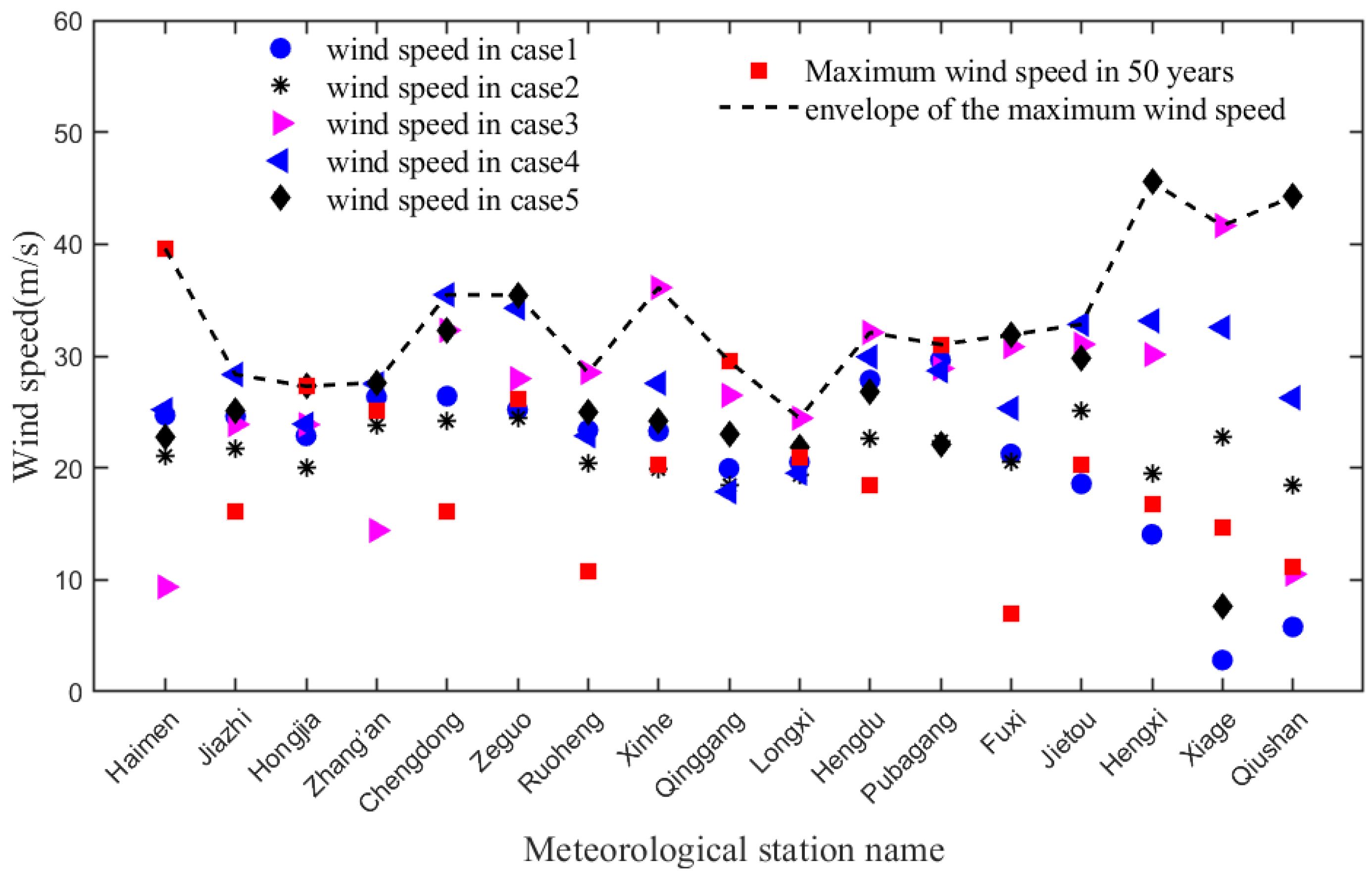
| Site Name | Altitude(m) | Wind Pressure (kN/m2) | ||
|---|---|---|---|---|
| R = 10 | R = 50 | R = 100 | ||
| Kuocangshan | 1383.1 | 0.60 | 0.90 | 1.05 |
| Hongjia | 1.3 | 0.35 | 0.55 | 0.65 |
| Xiadachen | 86.2 | 0.95 | 1.45 | 1.75 |
| Kanmen | 95.9 | 0.70 | 1.20 | 1.45 |
| Meteorological Station Number | M1 | M2 | M3 | M4 | M5 |
|---|---|---|---|---|---|
| Meteorological station name | Tiantai | Xianju | Linhai | Wenling | Hongjia |
| Latitude and longitude | 120°58′ E 29°09′ N | 120°43′ E 28°52′ N | 121°12′ E 28°52′ N | 121°22′ E 28°22′ N | 121°25′ E 28°37′ N |
| Measured maximum wind speed (m/s) | 21 | 19 | 20 | 23.5 | 23 |
| Maximum wind speed in 50-year return period (m/s) | 21.53 | 21.69 | 23.74 | 26.40 | 27.22 |
| Wind angle corresponding to maximum speed | ESE | NE | WNW | N | NNE |
| Wind Angle | (0–5] m/s | (5–8] m/s | (8–11] m/s | (11–14] m/s | (14–17] m/s | (17–20] m/s | x > 20 m/s | Total |
|---|---|---|---|---|---|---|---|---|
| N | 0.00 | 1.46 | 0.84 | 0.00 | 0.00 | 0.00 | 0.00 | 2.30 |
| NNE | 0.00 | 1.67 | 1.25 | 0.00 | 0.21 | 0.00 | 0.42 | 3.55 |
| NE | 0.00 | 0.63 | 1.46 | 0.42 | 0.84 | 0.00 | 0.42 | 3.76 |
| ENE | 0.00 | 5.85 | 4.59 | 1.46 | 0.00 | 0.00 | 0.21 | 12.11 |
| E | 0.00 | 3.97 | 2.30 | 0.21 | 0.00 | 0.00 | 0.21 | 6.68 |
| ESE | 0.00 | 0.63 | 2.09 | 0.63 | 0.00 | 0.00 | 0.00 | 3.34 |
| SE | 0.00 | 0.84 | 0.42 | 0.21 | 0.21 | 0.00 | 0.00 | 1.67 |
| SSE | 0.00 | 0.00 | 0.63 | 0.00 | 0.00 | 0.00 | 0.00 | 0.63 |
| S | 0.00 | 2.51 | 4.18 | 0.00 | 0.00 | 0.00 | 0.00 | 6.68 |
| SSW | 0.00 | 3.13 | 5.22 | 0.21 | 0.42 | 0.00 | 0.00 | 8.98 |
| SW | 0.00 | 0.21 | 0.21 | 0.00 | 0.00 | 0.00 | 0.00 | 0.42 |
| WSW | 0.00 | 0.21 | 0.00 | 0.00 | 0.00 | 0.21 | 0.00 | 0.42 |
| W | 0.00 | 0.42 | 0.00 | 0.21 | 0.00 | 0.00 | 0.00 | 0.63 |
| WNW | 0.00 | 6.05 | 4.59 | 0.84 | 0.42 | 0.00 | 0.00 | 11.90 |
| NW | 0.00 | 8.56 | 14.20 | 4.38 | 0.63 | 0.42 | 0.00 | 28.18 |
| NNW | 0.00 | 1.25 | 6.68 | 0.63 | 0.21 | 0.00 | 0.00 | 8.77 |
| Total | 0.00 | 37.37 | 48.64 | 9.19 | 2.92 | 0.63 | 1.25 | 100 |
| Grid Scheme | Maximum Horizontal Grid Size/m | Maximum Vertical Grid Size/m | Grid Number |
|---|---|---|---|
| Scheme 1 | 150 | 200 | 6.3 × 107 |
| Scheme 2 | 100 | 100 | 8.1× 107 |
| Scheme 3 | 50 | 50 | 1.25 × 108 |
| Topographic Condition | Approximate Length/m | Power Exponent a | Zero Plane Displacement d/m |
|---|---|---|---|
| Sea, mudflat, snow plain, etc. | 0.000–0.003 | 0.1–0.13 | 0 |
| Open country, open country with crops, fences, and a few trees | 0.003–0.2 | 0.14–0.2 | 0.1 |
| Dense forests, homes, suburbs | 0.2–1 | 0.2–0.25 | 5 |
| Cities | 1–2 | 0.25–0.3 | 10 |
| Big city center | 2–4 | 0.3–0.5 | 10 |
| Location | Type |
|---|---|
| Inlet | Velocity inlet |
| Outlet | Pressure outlet |
| Side surface | Symmetry |
| Top surface | Symmetry |
| Bottom surface | Wall |
| Case | Reference Weather Station Name | Maximum Wind Speed in 50-Year Return Period (m/s) | Wind Angle Corresponding to Maximum Speed | Elevation of the Wind Speed Acquisition Point (m) |
|---|---|---|---|---|
| Case 1 | Tiantai Station (M1) | 21.53 | ESE | 108.6 |
| Case 2 | Xianju Station (M2) | 21.69 | NE | 79.1 |
| Case 3 | Linhai Station (M3) | 23.74 | WNW | 6.8 |
| Case 4 | Wenling Station (M4) | 26.40 | N | 33.6 |
| Case 5 | Hongjia Station (M5) | 27.22 | NNE | 5.3 |
| Number | Stations | Observation Duration (Year) | v50 (m/s) | Simulated Wind Speed Data (m/s) | vs (m/s) | |||||
|---|---|---|---|---|---|---|---|---|---|---|
| Case 1 | Case 2 | Case 3 | Case 4 | Case 5 | ||||||
| 1 | Jiaojiang District/Haimen | 19 | 39.62 | 24.71 | 21.01 | 9.37 | 25.2 | 22.77 | 25.2 | −36.40 |
| 2 | Jiaojiang District/Jiazhi | 14 | 16.12 | 24.59 | 21.75 | 23.88 | 28.34 | 25.09 | 28.34 | 75.56 |
| 3 | Jiaojiang District/Hongjia (M5) | 51 | 27.27 | 22.87 | 19.98 | 23.87 | 23.91 | 27.30 | 27.30 | 0.11 |
| 4 | Jiaojiang District/Zhang’an | 19 | 25.13 | 26.34 | 23.75 | 14.41 | 27.52 | 27.62 | 27.62 | 9.83 |
| 5 | Wenling City/Chengdong | 14 | 16.17 | 26.41 | 24.16 | 32.3 | 35.47 | 32.34 | 35.47 | 119.54 |
| 6 | Wenling City/Zeguo | 19 | 26.14 | 25.21 | 24.44 | 27.97 | 34.28 | 35.44 | 35.44 | 7.12 |
| 7 | Wenling City/Ruoheng | 16 | 10.76 | 23.37 | 20.4 | 28.52 | 22.87 | 25.04 | 28.52 | 164.87 |
| 8 | Wenling City/Xinhe | 17 | 20.31 | 23.27 | 19.92 | 36.11 | 27.56 | 24.15 | 36.11 | 77.74 |
| 9 | Yuhuan District/Qinggang | 15 | 29.54 | 19.95 | 18.46 | 26.49 | 17.86 | 22.97 | 26.49 | −10.33 |
| 10 | Yuhuan District/Longxi | 9 | 20.92 | 20.52 | 19.32 | 24.45 | 19.53 | 21.91 | 24.45 | 16.85 |
| 11 | Sanmen District/Hengdu | 8 | 18.52 | 27.85 | 22.66 | 32.10 | 29.92 | 26.75 | 32.10 | 73.33 |
| 12 | Sanmen District/Pubagang | 15 | 31.03 | 29.65 | 22.43 | 28.89 | 28.68 | 22.14 | 29.65 | −4.46 |
| 13 | Tiantai District/Fuxi | 9 | 6.92 | 21.24 | 20.48 | 30.83 | 25.32 | 31.88 | 31.88 | 360.47 |
| 14 | Tiantai District/Jietou | 15 | 20.31 | 18.58 | 25.15 | 31.04 | 32.83 | 29.81 | 32.83 | 61.67 |
| 15 | Xianju District/Hengxi | 15 | 16.70 | 14.06 | 19.52 | 30.12 | 33.14 | 45.55 | 45.55 | 172.76 |
| 16 | Xianju District/Xiage | 9 | 14.71 | 2.83 | 22.80 | 41.65 | 32.56 | 7.67 | 41.65 | 183.03 |
| 17 | Xianju District/Qiushan | 7 | 11.15 | 5.79 | 18.41 | 10.51 | 26.26 | 44.24 | 44.24 | 296.69 |
| Number | Station | Observation Duration (Year) | Altitude (m) | W50 (kN/m2) | ws (kN/m2) | w1 (kN/m2) |
|---|---|---|---|---|---|---|
| 1 | Jiaojiang District/Haimen | 19 | 3 | 0.98 | 0.40 | 0.98 |
| 2 | Jiaojiang District/Jiazhi | 14 | 5 | 0.16 | 0.50 | 0.50 |
| 3 | Jiaojiang District/Hongjia | 51 | 5 | 0.46 | 0.47 | 0.47 |
| 4 | Jiaojiang District/Zhang’an | 19 | 5.3 | 0.39 | 0.48 | 0.48 |
| 5 | Wenling City/Chengdong | 14 | 185 | 0.16 | 0.77 | 0.77 |
| 6 | Wenling City/Zeguo | 19 | 184 | 0.42 | 0.77 | 0.77 |
| 7 | Wenling City/Ruoheng | 16 | 5 | 0.07 | 0.51 | 0.51 |
| 8 | Wenling City/Xinhe | 17 | 7 | 0.26 | 0.81 | 0.81 |
| 9 | Yuhuan District/Qinggang | 15 | 18 | 0.54 | 0.44 | 0.54 |
| 10 | Yuhuan District/Longxi | 9 | 48 | 0.27 | 0.37 | 0.37 |
| 11 | Sanmen District/Hengdu | 8 | 52 | 0.21 | 0.64 | 0.64 |
| 12 | Sanmen District/Pubagang | 15 | 15 | 0.60 | 0.55 | 0.60 |
| 13 | Tiantai District/Fuxi | 9 | 52 | 0.03 | 0.63 | 0.63 |
| 14 | Tiantai District/Jietou | 15 | 113 | 0.25 | 0.67 | 0.67 |
| 15 | Xianju District/Hengxi | 15 | 116 | 0.17 | 1.28 | 1.28 |
| 16 | Xianju District/Xiage | 9 | 142 | 0.13 | 1.07 | 1.07 |
| 17 | Xianju District/Qiushan | 7 | 150 | 0.08 | 1.21 | 1.21 |
Publisher’s Note: MDPI stays neutral with regard to jurisdictional claims in published maps and institutional affiliations. |
© 2022 by the authors. Licensee MDPI, Basel, Switzerland. This article is an open access article distributed under the terms and conditions of the Creative Commons Attribution (CC BY) license (https://creativecommons.org/licenses/by/4.0/).
Share and Cite
Li, R.; Wang, Y.; Lin, H.; Du, H.; Wang, C.; Chen, X.; Huang, M. A Mesoscale CFD Simulation Study of Basic Wind Pressure in Complex Terrain—A Case Study of Taizhou City. Appl. Sci. 2022, 12, 10481. https://doi.org/10.3390/app122010481
Li R, Wang Y, Lin H, Du H, Wang C, Chen X, Huang M. A Mesoscale CFD Simulation Study of Basic Wind Pressure in Complex Terrain—A Case Study of Taizhou City. Applied Sciences. 2022; 12(20):10481. https://doi.org/10.3390/app122010481
Chicago/Turabian StyleLi, Ruige, Yanru Wang, Hongjian Lin, Hai Du, Chunling Wang, Xiaosu Chen, and Mingfeng Huang. 2022. "A Mesoscale CFD Simulation Study of Basic Wind Pressure in Complex Terrain—A Case Study of Taizhou City" Applied Sciences 12, no. 20: 10481. https://doi.org/10.3390/app122010481
APA StyleLi, R., Wang, Y., Lin, H., Du, H., Wang, C., Chen, X., & Huang, M. (2022). A Mesoscale CFD Simulation Study of Basic Wind Pressure in Complex Terrain—A Case Study of Taizhou City. Applied Sciences, 12(20), 10481. https://doi.org/10.3390/app122010481







